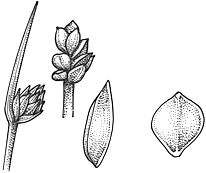Isolepis aucklandica Hook.f. APNI* Synonyms: Scirpus aucklandicus (Hook.f.) Boeckeler APNI*

Description: Small clump-forming perennial, with short filiform rhizome.
Culms filiform, to 12 cm high.
Leaves reduced, shorter than culms. Spikelet 1 (rarely 2), 1–2.5 mm long; involucral bract much longer than spikelet, caducous, with base partially enclosing spikelet. Glumes acute, not or scarcely mucronate, sides irregularly several-nerved, 1.2–2 mm long, pale brown often dotted or tinged dark red-brown, deciduous. Stamens 3, rarely fewer in upper flowers; anthers 0.5–0.8 mm long. Style 3-fid.
Nut unequally trigonous, with angles acute, ellipsoid, two-thirds to three-quarters as long as glume, 0.8–1.5 mm long, 0.6–0.9 mm diam., minutely reticulate, shining, pale yellow to grey-brown; often persistent on bare rachilla.
Flowering: summer.
Distribution and occurrence: Grows in stream banks and swamps at high altitudes (to alpine); higher tablelands (Barrington Tops, Brindabella Ra., and Kosciusko area).
NSW subdivisions: NT, ST
Other Australian states: Qld Vic. Tas.
Characteristically, this species is found with the glumes and involucral bract fallen, leaving the nuts persistent on the bare axis of the spikelet.
Text by K. L. Wilson
Taxon concept: Flora of NSW 4 (1993)
APNI* Provides a link to the Australian Plant Name Index (hosted by the Australian National Botanic Gardens) for comprehensive bibliographic data
***The AVH map option provides a detailed interactive Australia wide distribution map drawn from collections held by all major Australian herbaria participating in the Australian Virtual Herbarium project.
|


